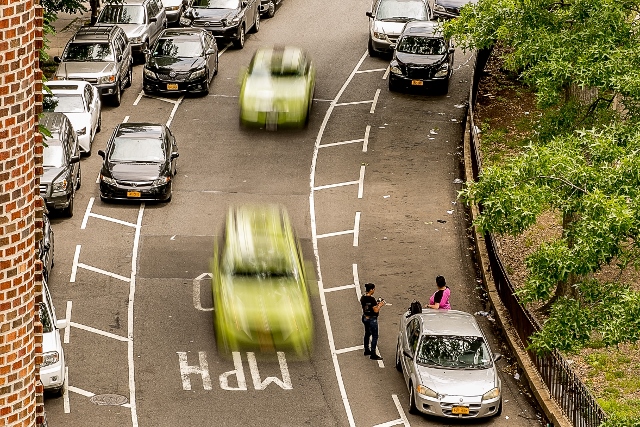
Photo by Adi Talwar
By DAVID CRUZ
Across Norwood and beyond, the search for parking remains an everyday scourge for thousands of drivers. Neighbors and employees around the various stores and two local hospitals rely on parking daily, though searching for a legal spot can cut into the workday. Residents have long complained it can take upwards to a half hour to locate a spot.
The quest for parking may be further complicated by a proposal under Mayor Bill de Blasio’s Housing New York initiative, which seeks to build or preserve 200,000 units of affordable housing. To fulfill de Blasio’s vision, the plan aims to permanently waive a 65-year-old requirement for landlords to create off-street parking. This would also apply to affordable senior housing, specialized residences which city officials estimate is in dire short supply.
The topic was addressed at a joint Community Board 7 Land Use/Housing and Senior Services committees meeting on June 17, part of a lengthy public review that could last through the year. Should this provision be approved, members argued, it would decrease supply for public parking, aggravating the hassle to secure street parking in Norwood and now more burgeoning Bedford Park.
“People are desperately always looking for parking spaces,” said Jean Hill, CB7’s chair of the Land Use/Zoning committee. “There’s not that many garages anymore where they offer you a space to park the car, which is why this is such a sensitive issue.”
Transit Options
Analysts from the New York City Department of City Planning (DCP), the agency promoting the plan across the Bronx, reviewed data from the state Department of Motor Vehicles and found current off-street parking spots are

Image courtesy Department of City Planning
underutilized citywide since many low-income families do not drive and live near public transportation.
Working against Community District 7, home to the neighborhoods of Norwood, Bedford Park, Kingsbridge, Fordham, and University Heights, is its proximity to transit. DCP officials categorized the neighborhoods falling within a proposed Transit Zone, areas that have easy access to public transportation. The neighborhoods overlap with subway service via the B, D, 2, 4 and 5 lines. Affordable housing developers will not have to build parking in Transit Zones.
Parking Rules
A DCP official noted current parking requirements for affordable buildings are already low–12 to 42 percent. Figures for affordable senior housing are lower—only 10 to 30 percent have a parking requirement.
As it stands, affordable housing landlords carve out space for off-street parking spots, which runs anywhere from $20,000 to $50,000 in construction expenses. The off-street parking rule was instituted in New York City in 1950 to ease congestion.
Attending the meeting was Ted Weinstein, the Bronx Planning Director for the Department of Housing Preservation and Development, the agency that offers tax breaks and subsidized loans to affordable housing developers. Weinstein, arguing for the city’s justification of eliminating spots, told committee members he walks through garages and sees “very few cars being used.”
“An affordable housing developer can build a building with 100 apartments and you’ll have, let’s say, 15 to 25 spaces, and maybe five of them might be used,” said Weinstein. “And that is a waste.”
But thresholds can often be avoided. In some cases, developers get a waiver so long as they prove there are insufficient units to trigger the parking requirement. Another way developers circumvent the parking requirement is by building smaller, subdivided buildings on a larger lot. With smaller-unit buildings, the need to provide parking does not apply.
By exempting property owners from creating parking spots, building affordable housing ultimately becomes cheaper and less restrictive, allowing crews to build more housing in tighter spaces. Landlords, who rely on loans to build affordable housing, can be more incentivized to build affordable housing units, which generate more revenue than parking.
The Search for Parking
Along Williamsbridge Oval Park, drivers can luck out quickly and secure a spot or circle the Oval multiple times around their neighborhoods before finding parking. During alternate side hours, traffic agents allow drivers to legally double park for 90 minutes so the New York City Sanitation Department can clean the streets.
“If you come here in the morning and the evening, it’s a zoo of people driving,” said Paul Foster, CB7’s Senior Services Committee member. “People living here have to wait at sometimes 45 minutes to an hour just to get a parking space, and wait for the change of shifts.” Foster suggested DCP should adapt its housing plan according to the needs of city neighborhoods.
Coinciding with the growing parking problem is a sharp increase in development in Bedford Park by new investors. The neighborhood has become quite marketable, with organizations such as The Stagg Group buying empty lots to create housing. In its most finished project, The Stagg Group circumvented the parking requirement by dividing their lot into smaller buildings.
“This community is going up, we’re going to need more parking for the regular parking,” said Adaline Walker-Santiago, chair of CB7. “The senior people do need cars to get around.”
Public Review
As most city initiatives, Housing New York requires a public review that will go all the way to the New York City Council and to de Blasio’s desk. The initiative is high on the mayor’s agenda, but he’ll likely face opposition from the Board.
At the meeting, Councilman Andrew Cohen, representing parts of Community District 7, pledged to oppose an off-street parking ban once it arrives at City Hall. “I met with City Planning already, and I told City Planning that, under no unequivocal terms, that if my community boards don’t support, I’m not going to support it,” he said.




